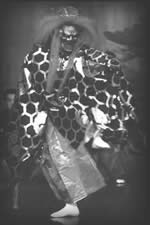
BF. William Empson
19. ‘A Full-Blown Lily’. Review of The Lotus and the Robot, by Arthur Koestler. New Statesman NS 61 (January 1961): 21-22.
 |
||
| Not ‘Celtic Twilight’, but ‘a good old South Sea Island war dance, stamping like a buck rabbit, to a terrific chorus of yowling’. |
Empson criticises Koestler’s attitudes toward the nô and Japanese Buddhism, and thereby reveals something of his own. Koestler suggests that the emotions of the nô are ‘daintified’, but Empson knows better, and knows as well, unlike most earlier commentators in English, that a nô performance and a nô text should not be confused. Koestler, he suggests, had not seen the play through to its end, for if he had, ‘he would . . . have found the ghost of the warrior doing a good old South Sea Island war dance, stamping like a buck rabbit, to a terrific chorus of yowling’. The ‘forces of the world are strong at the end in the music and dance’, Empson writes, ‘as they need to be since loyalty to them keeps the ghost from his peace; but, as they are not in the words, we tend to assume that the whole performance is just Celtic Twilight’ (see 8 for a fuller treatment of the point). Regarding Japanese Buddhism, Koestler identifies it primarily with Zen, but Empson notes that neither Buddhism nor Japan are ‘all Zen’, and indeed ‘much of Japanese Buddhism is very like the Church of England, both in its weaknesses and virtues’.

